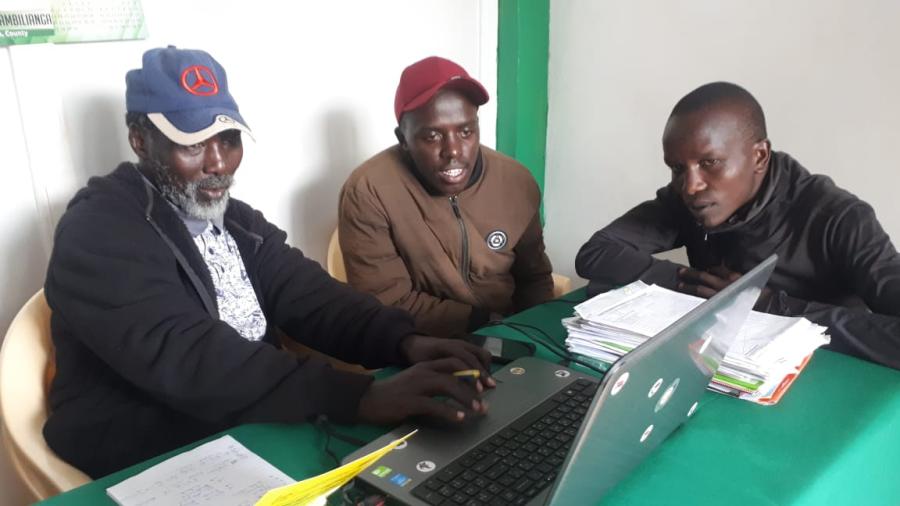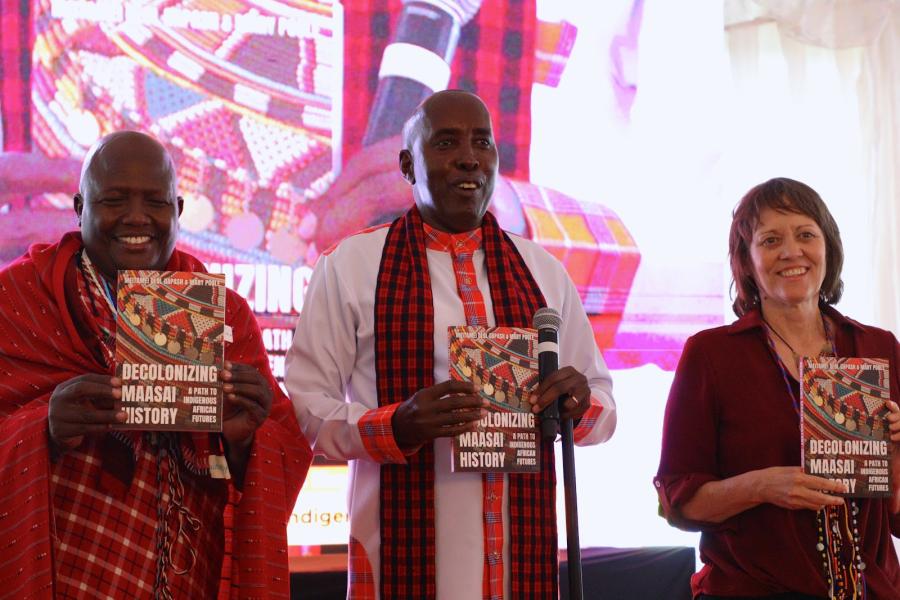The food supply of African pastoralists is precarious even in the best of times. When raiding, drought, and disease reduce the number and strength of the livestock upon which pastoralists' livelihood depends, shortages and famine often result. If circumstances permit, pastoralists will follow traditional strategies for coping with the problem, or if effective aid comes from the outside, disaster may be averted. However, even if external aid is effective in the sense of saving lives in the short term, it may pave the way for future difficulties. Problems are particularly likely if relief leads to the creation of permanent famine camps and if relief agencies or governments launch into large-scale, long-term development projects before adequate assessment and planning have occurred to ensure the participation of the pastoralists and the viability of the scheme.
Beginning in the 1920s, the Turkana nomads of northwestern Kenya received outside famine relief on a number of occasions. The famine of 1980-81 is the most recent, but famines in 1960-61 and 1974-75 also occasioned large-scale relief efforts. At the height of the 1980-81 famine and for over a year thereafter (at least until May 1982), 70,000-80,000, or one half of the estimated 140-160,000 Turkana resident in Turkana District, were on relief rolls. Many, particularly women and children, lived in famine camps for long periods of time.
The government of Kenya's existing famine relief program was unable to cope with the scale of the problems. Initial external food supplies came from charitable and religious organizations, notably Catholic Relief Services. Later, food came from the European Economic Community via the World Food Program. In January 1981 it became clear that a large volume of food relief would be required for a considerable period of time. The Turkana Rehabilitation Project (TRP) was created as a government project, "with the objectives of emergency feeding, rehabilitation of the land, provision of rural services and the rehabilitation of the population through the provision of viable small herds of small stock". In the official rationale for the creation of the TRP, one of the main forms of rehabilitation was stated to be the provision of small stock. This document and interviews with TRP officials indicate that the original intent was to revive the traditional, livestock-based livelihood of the Turkana.
By late 1982, two years after the peak of the famine, TRP officials came to the conclusion that relief had to be curtailed:
Urgent measures are now being taken to phase out emergency feeding into rehabilitation activities which will have a medium and long-term effect on the land and the people. The input of food in support of properly designed and supervised projects, through food-for-work, would ensure that the hardest hit still have access to food whilst engaging in development activities.
To accomplish this, the Government of Kenya requested a sufficient supply of maize, beans, and oil from the World Food Program to sustain a five-year food-for-work effort, to begin in April 1983. However, this plan focused on irrigation schemes for settled agriculture, a way of life markedly different from the pastoral nomadism of the Turkana, and from the original TRP pastoralist-focused rehabilitation scheme.
The thrust of this revised development policy raises several questions: Why did the shift from reviving pastoralism to encouraging settled agriculture occur? What effect on Turkana food security would this development agenda have if it were effectively implemented? Before dealing with these issues, it is necessary to briefly review the causes of the 1980-81 famine and the relative success of the emergency intervention which paved the way for the TRP's longer-term development plan.
Causes of the Famine
Most observers agree that the root causes of the famine were external to Turkana and had to do with the ways in which the broader world has impinged upon it. However, there are differences in the way in which this relationship is seen. Some authorities in the TRP see the root causes of the famine in terms of nomadic traditions which may once have been viable but now, because of increased human and livestock populations and reduced land area, lead to a cycle of overbreeding and overgrazing. When droughts come, as they always have, livestock die for lack of food or water, and then people go hungry. Before the establishment of colonial and later national borders, the Turkana could move into areas not affected by drought. They also raided livestock from neighboring tribes, both to survive and to restock after the drought had passed. Now, the theory goes, the closing of borders, and the Kenya government's appropriation of some of the areas which used to be dry season havens, concentrates the enlarged herds in a smaller, dryer area.
In addition, the influx of arms and munitions into the area, particularly from Idi Amin's former armies, has escalated the level of violence and changed the balance of power between raiding tribes, greatly exacerbating the problems of moving herds into traditional dry season grasslands, especially in the southern part of Turkana. Indeed, many observers argue that the virtual certainty of violent raiding may have been a more important cause of the famine than the drought in that it both blocked access to traditional grazing areas and led the Turkana to concentrate large numbers of livestock around safe watering sites. This made possible the rapid spread of diseases, including anthrax, which killed many of the animals in early 1980.
The increased likelihood of raiding meant that herders moved their stock frequently, making them even more vulnerable to raiding. Ironically, because the increased raiding has kept the Turkana from using some of the better grazing areas, especially in South Turkana, the Government of Kenya is now claiming the "unused" land for development projects. In the long run, this will make it even more difficult for pastoralists to remain self-reliant in food during crisis years.
The death of livestock in 1980 eventually led to widespread human hunger. Grain imports from the south were slowed by the nationwide shortage in 1979, and by government regulations aimed at controlling the movements of grain to discourage its smuggling across the borders. The already-weakened population was further affected by cholera and measles. The missions began to respond to the need for food in February 1980, and the Government of Kenya around October 1980, but large-scale supplies of relief food did not begin arriving until the TRP's efforts got underway in January 1981.
One irony is that, when their livestock first began dying in early 1980, the Turkana had large amounts of cash from the sale of the animals' skins. However, traders could not obtain permits from the District government to import grain. They could and did, however, bring in soft drinks.
The origins of famine in Turkana may lie even deeper. Colonial and, later, Kenya government policies affecting land use, taxation, and marketing of livestock may in fact have led to a cycle of livestock overbreeding, overgrazing, and hence drought and famine in Turkana. However, after independence, there was no marketing of livestock other than goats out of the District. Overbreeding is at least as likely to arise from the traditional desire to have as many animals as possible. Whether or not the earlier taxation and market scheme led to overbreeding in Turkana, it apparently has elsewhere in Africa. Putting too much emphasis on developing Turkana as an area of livestock production for the national market, while preserving the pastoral way of life, might simply exacerbate the cycle of overbreeding and overgrazing. However, as will be seen below, the contrasting strategy of resettling thousands of Turkana on irrigation projects is probably more fraught with peril, as is any rapid, large-scale, top-down attempt at rehabilitation of a delicately balanced human and ecological setting with a history of disasters.
Current Rehabilitation Plans
In the request by the Kenya government to the World Food Program for assistance for rehabilitation activities in Turkana District submitted early in 1983, all but one of the food-for-work projects described are irrigation projects for settled agriculture. The other is a tree planting project.
The nine food-for-work projects described are projected to involve 5,000 families annually (approximately 25,000 people) for a period of five years. TRP officials indicated that food would be provided for families until their first harvest, presumably a period of one year. If, as seems likely, the plan calls for an annual intake of new families, for all nine projects, by 1988 a total population of 25,600 families or 125,000 Turkana, a large percentage of the entire population of 140,000-160,000 would eventually have been involved. As plans call for the families who participate in irrigation projects to settle and continue to work the land which they have improved, this would mean the permanent settlement of a large proportion of the Turkana people. If this is indeed the outcome of the scheme, famine relief may well have begotten renewed famine. At best, this would demonstrate bad planning; at worst, the tendency for bureaucracies to generate self-perpetuating plans with little regard for the intended beneficiaries.
The primary justification for the current rehabilitation emphasis appears to lie with the TRP's definition of the root problem: "Given the physical potential of Turkana, it appears that its present human and livestock population may be close to the ecological maximum under existing pastoral practices". This analysis naturally leads to an exploration of non-pastoral alternatives, notably irrigation schemes.
The experience of church-sponsored irrigation schemes points to the difficulties in establishing such projects: Turkana social structure lacks a tradition of strong centralized leadership and Turkana are socialized to be highly individualistic. It has been difficult to get their participation in the running of irrigation projects. Even after a number of years of work, they do not feel that the project is "their own," with the result that they do not put their full energies into it.
Projects Utilizing Food-for-Work Under the TRP
Number of workers per annum
Nakwamoru 500
Lokori 350
Kerio delta 300
Lorengipi 200
Lake shore 400
Kakuma/Lotikipi/Lokchoggio 700
Turkwell 60
Katilu 226
Amolem 270
Tree planting 1,994
_______
Total 5,000
x 5 persons per family
_______
25,000
(Source: Government of Kenya, n.d.:19)
Another complaint commonly heard in Turkana is that the TRP is using food as a way of coercing people living in the camps to move to irrigation projects. One of the three members of Parliament from Turkana voiced this criticism in the spring of 1983. Their outcry may, however, be motivated more by a desire to continue free food distribution to their constituencies than a concern with the alleged coercion.
A final but basic problem with the TRP rehabilitation scheme is that, flawed though it is, it may never be implemented. One large segment of it, the food-for-work projects, may not receive adequate funding to be sustained. Two-fifths of the funding, the money for transport of the food, must come from the Kenya government. In the spring of 1983 there was some question whether these funds would be available because of the economic crisis which made deep cuts in the national budget.
Possible Solutions
If successful, this development trajectory might be even more precarious for the Turkana than their traditional livestock-based way of life. This criticism should not discourage assistance to small groups of interested Turkana who wish to attempt cultivation in sites that have been seen to be appropriate. However, it courts disaster to rush into large-scale attempts to develop irrigation projects in unproven settings with Turkana who feel coerced to move simply to retain access to food. By the same token, livestock restocking and marketing schemes could be disastrous were they to be undertaken too rapidly and without the active and enthusiastic participation of the Turkana.
No clear and simple prescriptions for a rehabilitation scheme can be made. However people close to the scene have suggested that if food-for-work were given for pastoral activities, not just settled cultivation, the Turkana might participate with more enthusiasm and become self-reliant more quickly. There are admittedly problems of distribution associated with such a plan, but efforts should be made to work them out. Tree planting, which in fact receives a considerable slice of the resources proposed in the current plan, is also seen as an appropriate use of food-for-work. If it is acknowledged that the violence of the current level of raiding was a key causal factor in the famine of 1980-81, and in the slow recovery from it, it would seem that a serious effort to control the raiding would be a necessary prerequisite to any development plan. Many TRP officials recognize this problem, but to date have been able to do little to influence the situation. Finally, more than any simple discrete goal, the rehabilitation of Turkana should aim at the creation of a process to involve the Turkana people and should strive to combine the traditional pastoral way of life with new alternatives, including irrigated cultivation. To its credit, the TRP did fund a large-scale education and leadership training project in the famine camps. Without continued emphasis on this process, virtually any development strategy will fail.
Conclusion
The basic difficulty with the manner in which famine relief efforts have led to a rehabilitation plan in Turkana is that a shift in emphasis has occurred from restocking and a return to pastoralism, on one hand, to sedentary farming based on irrigation and water harvesting on the other. The shift is not based on a careful study of the ecological limits of the environment, nor on careful analysis of the limitations demonstrated by earlier irrigation attempts with pastoralists in Turkana or elsewhere. While small-scale experimentation with irrigation and water harvesting makes excellent sense as a supplement to pastoralism in Turkana, the speed and scale with which this strategy is currently being pursued could, if successful, make large numbers of Turkana dependent upon sedentary agriculture for primary subsistence. This not only threatens their traditional pastoral way of life, it may actually threaten their lives in the event of renewed drought or any of the other cyclical ecological catastrophes to which the region is prone.M.O<
In short, famine relief and redevelopment that lead the Turkana into a rapid and large-scale shift from pastoralism to settled agriculture could pave the way for renewed famine. Small-scale experiments which can demonstrate effectiveness both in the sense of involving the Turkana in the planning and ongoing management of the schemes and of being technically and ecologically viable are necessary before the launching of large-scale efforts. In the meantime, it would seem that the majority of food-for-work projects should encourage return to pastoralism and the rebuilding of the environment.
Article copyright Cultural Survival, Inc.



